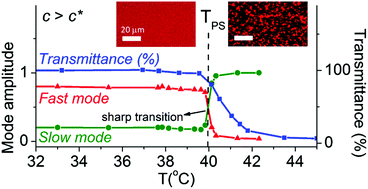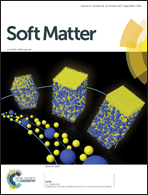Optical tracking of relaxation dynamics in semi-dilute hydroxypropylcellulose solutions as a precise phase transition probe
Abstract
Phase separation of thermo-responsive polymers in solution is a complex process, whose understanding is essential to screen and design materials with diverse technological applications. Here we report on a method based on dynamic light scattering (DLS) experiments to investigate the phase separation of thermo-responsive polymer solutions and precisely define the transition temperature (TPS). Our results are applied on hydroxypropylcellulose (HPC) solutions as an important biosourced green water-soluble polymer. As determined by DLS, the amplitudes of the fast and slow modes of relaxation dynamics evolve as temperature gets closer to the phase transition point eventually leading to phase separation. The evolution of relaxation modes with temperature is markedly different for concentrations below the overlap concentration (c*) (dilute regime), above c* (semi-dilute regime) and above the entanglement concentration (ce). In the three cases though, the fast and slow mode amplitudes undergo a sharp transition in a narrow temperature range, defining accurately the phase separation locus. The results agree with turbidimetric analysis for the phase transition determination but with a better precision. Our results also show that the one-phase dynamics and phase separation dynamics in the two-phase region are only in continuity for c > ce, revealing mechanistic details about the HPC phase separation process. Above TPS we identify a temperature range where the intensity autocorrelation function has a single-exponential shape. In the latter regime, we monitor the growth kinetics of polymer domains and provide clues to rationalize the stabilizing effects of the interfaces leading to the arrested-like phase separation behavior observed for HPC.



 Please wait while we load your content...
Please wait while we load your content...